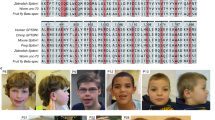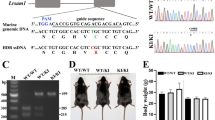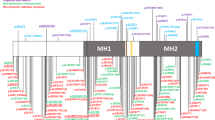Abstract
The adhesion molecule L1 is a member of the immunoglobulin super-family1. L1 is involved in various recognition processes in the CMS and PNS2–3, and binding to L1 can activate signal transduction pathways4,5. Mutations in the human L1 gene are associated with a variable phenotype, including mental retardation and anomalous development of the nervous system, referred to as ‘CRASH’ (corpus callosum hypoplasia, retardation, adducted thumbs, spastic paraplegia, and hydrocephalus)6. We generated an animal model of these conditions by gene targeting. Mutant mice were smaller than wild-type and were less sensitive to touch and pain, and their hind-legs appeared weak and uncoordinated. The size of the corticospinal tract was reduced and, depending on genetic background, the lateral ventricles were often enlarged. Non-myelinating Schwann cells formed processes not associated with axons and showed reduced association with axons. In vitro, neurite outgrowth on an L1 substrate and fasciculation were impaired. The mutant mouse described here will help to elucidate the functions of L1 in the nervous system and how these depend on genetic influences.
This is a preview of subscription content, access via your institution
Access options
Subscribe to this journal
Receive 12 print issues and online access
$209.00 per year
only $17.42 per issue
Buy this article
- Purchase on Springer Link
- Instant access to full article PDF
Prices may be subject to local taxes which are calculated during checkout
Similar content being viewed by others
References
Moos, M. et al. Neural adhesion molecule L1 as a member of the immunoglobulin superfamily with binding domains similar to fibronectin. Nature. 334, 701–703 (1988).
Kadmon, G. & Altevogt, P. The cell adhesion molecule L1: species- and cell-type-dependent multiple binding mechanisms. Differentiation. 61, 143–150 (1997).
Martini, R. Expression and functional roles of neural cell surface molecules and extracellular matrix components during development and regeneration of peripheral nerves. J. Neumcytol. 23, 1–28 (1994).
Doherty, P., Smith, P. & Walsh, F.S. Shared cell adhesion molecule (CAM) homology domains point to CAMs signalling via FGF receptors. Perspect. Dev. Neurobiol. 4, 157–168 (1996).
Maness, P.P., Beggs, H.E., Klinz, S.G. & Morse, W.R. Selective neural cell adhesion molecule signaling by Src family tyrosine kinases and tyrosine phosphatases. Perspect Dev. Neurobiol. 4, 169–181 (1996).
Fransen, E. et al. CRASH syndrome: clinical spectrum of corpus callosum hypoplasia, retardation, adducted thumbs, spastic paraparesis and hydrocephalus due to mutations in one single gene, L1. Eur. J. Hum. Genet. 3, 273–284 (1995).
Sadoul, K., Sadoul, R., Faissner, A. & Schachner, M. Biochemical characterization of different molecular forms of the neural cell adhesion molecule L1. J. Neurochem. 50, 510–521 (1988).
Mah, C., Suissa, A. & Anisman, H. Dissociation of antinociception and escape deficits induced by stress in mice. J. Comp. Physiol. Psychol. 94, 1160–1171 (1980).
Schrander-Stumpel, C. et al. Spectrum of X-linked hydrocephalus (HSAS), MASA syndrome, and complicated spastic paraplegia (SPG1): clinical review with six additional families. Am. J. Med. Genet. 57, 107–116 (1995).
Fransen, E., Van Camp, G & Willems, P.J. The clinical spectrum of mutations in L1, a neurbnal cell adhesion molecule. Am. J. Med. Genet. 64, 73–77 (1996).
Ramanathan, R., Wilkemeyer, M.F., Mittal, B., Perides, G. & Charness, M.E. Alcohol inhibits cell-cell adhesion mediated by human L1. J. Cell Biol. 133, 381–390 (1996).
Fischer, G., Kunemund, V. & Schachner, M. Neurite outgrowth patterns in cerebellar microexplant cultures are affected by antibodies to the cell surface glycoprotein L1. J. Neurosci. 6, 605–612 (1986).
Stallcup, W.B. & Beasley, L. Involvement of the nerve growth factor–inducible large external glycoprotein (NILE) in neurite fasciculation in primary cultures of rat brain. Proc. Nat. Acad. Sci. USA 82, 1276–1280 (1985).
Lindner, J., Rathjen, F.G. & Schachner, M. L1 mono- and polyclonal antibodies modify cell migration in early postnatal mouse cerebellum. Nature. 305, 427–430 (1983).
Miura, M., Asou, H., Kobayashi, M. & Uyemura, K. Functional expression of a full-length cDNA coding for rat neural cell adhesion molecule L1 mediates homophilic intercellular adhesion and migration of cerebellar neurons. J. Biol. Chem. 267, 10752–10758 (1992).
Holm, J. et al. Structural features of a close homologue of L1 (CHL1) in the mouse: a new member of the L1 family of neural recognition molecules. Eur. J. Neurosci. 8, 1613–1629 (1996).
Seilheimer, B., Persohn, E. & Schachner, M. Antibodies to the L1 adhesion molecule inhibit Schwann cell ensheathment of neurons in vitro. J. Cell Biol. 109, 3095–3103 (1989).
Williams, E.J., Furness, J., Walsh, F.S. & Doherty, P. Activation of the FGF receptor underlies neurite outgrowth stimulated by L1, N-CAM, and N-cadherin. Neuron. 13, 583–594 (1994).
Appel, F., Holm, J., Conscience, J.F. & Schachner, M. Several extracellular domains of the neural cell adhesion molecule L1 are involved in neurite outgrowth and cell body adhesion. J. Neurosci. 13, 4764–4775 (1993).
Bixby, J.L. & Jhabvala, P. Extracellular matrix molecules and cell adhesion molecules induce neurites through different mechanisms. J. Cell Biol. 111, 2735–2732 (1990).
Lemmon, V., Farr, K.L. & Lagenaur, C. L1-mediated axon outgrowth occurs via a homophilic binding mechanism. Neuron. 2, 1597–1603 (1989).
Reis, L.F.L., Ruffner, H., Stark, G., Aguet, M. & Weissmann, C. Mice devoid of interferon regulatory factor 1 (IRF-1) show normal expression of type I interferon genes. EMBO J. 13, 4798–4806 (1994).
Appel, F. et al. Identification of the border between fibronectin type III homologous repeats 2 and 3 of the neural cell adhesion molecule L1 as a neurite outgrowth promoting and signal transducing domain. J. Neurobiol. 28, 297–312 (1995).
Klinz, S.G., Schachner, M. & Maness, P.F. L1 and N-CAM antibodies trigger protein phosphatase activity in growth cone-enriched membranes. J. Neurochem. 65, 84–95 (1995).
Martini, R., Zielasek, J., Toyka, K.V., Giese, K.P. & Schachner, M. Protein zero (PO)-deficient mice show myelin degeneration in peripheral nerves characteristic of inherited human neuropathies. Nature Genet. 11, 281–286 (1995).
Martini, R., Mohajeri, M.H., Kasper, S., Giese, K.P. & Schachner, M. Mice doubly deficient in the genes for PO and myelin basic protein show that both proteins contribute to the formation of the major dense line in peripheral nerve myelin. J. Neurosci. 15, 4488–4495 (1995).
Lagenaur, C. & Lemmon, V., L1-like molecule, the 8D9 antigen, is a potent substrate for neurite extension. Proc. Natl. Acad. Sci. USA. 84, 7753–7757 (1987).
Constam, D.B., Schmid, P., Aguzzi, A., Schachner, M. & Fontana, A. Transient production of TGF-P2 by postnatal cerebellar neurons and its effect on neuroblast proliferation. Eur. J. Neurosci. 6, 766–778 (1994).
Author information
Authors and Affiliations
Corresponding author
Rights and permissions
About this article
Cite this article
Dahme, M., Bartsch, U., Martini, R. et al. Disruption of the mouse L1 gene leads to malformations of the nervous system. Nat Genet 17, 346–349 (1997). https://doi.org/10.1038/ng1197-346
Received:
Accepted:
Issue Date:
DOI: https://doi.org/10.1038/ng1197-346
This article is cited by
-
Ptpn20 deletion in H-Tx rats enhances phosphorylation of the NKCC1 cotransporter in the choroid plexus: an evidence of genetic risk for hydrocephalus in an experimental study
Fluids and Barriers of the CNS (2022)
-
Peripheral Nerve Development and the Pathogenesis of Peripheral Neuropathy: the Sorting Point
Neurotherapeutics (2021)
-
L1CAM defines the regenerative origin of metastasis-initiating cells in colorectal cancer
Nature Cancer (2020)
-
The cell adhesion protein CAR is a negative regulator of synaptic transmission
Scientific Reports (2019)
-
L1cam-mediated developmental processes of the nervous system are differentially regulated by proteolytic processing
Scientific Reports (2019)



